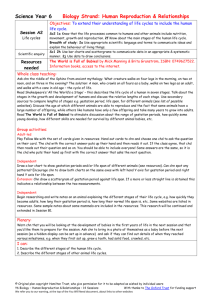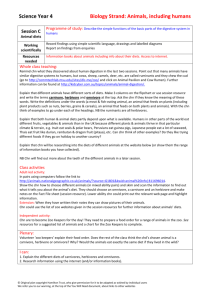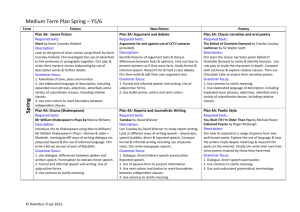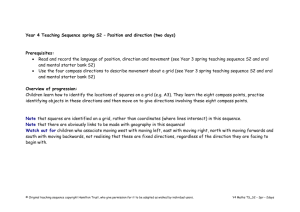Autumn TS 12 - Hamilton Trust
advertisement
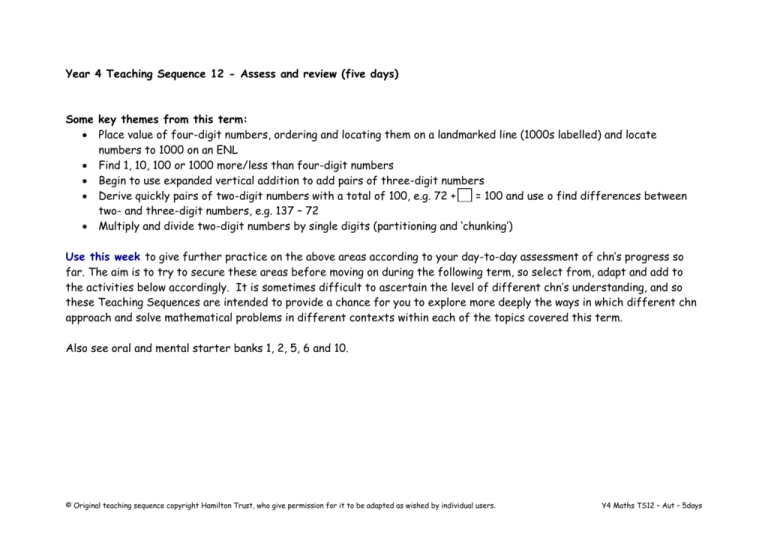
Year 4 Teaching Sequence 12 - Assess and review (five days) Some key themes from this term: Place value of four-digit numbers, ordering and locating them on a landmarked line (1000s labelled) and locate numbers to 1000 on an ENL Find 1, 10, 100 or 1000 more/less than four-digit numbers Begin to use expanded vertical addition to add pairs of three-digit numbers Derive quickly pairs of two-digit numbers with a total of 100, e.g. 72 + = 100 and use o find differences between two- and three-digit numbers, e.g. 137 – 72 Multiply and divide two-digit numbers by single digits (partitioning and ‘chunking’) Use this week to give further practice on the above areas according to your day-to-day assessment of chn’s progress so far. The aim is to try to secure these areas before moving on during the following term, so select from, adapt and add to the activities below accordingly. It is sometimes difficult to ascertain the level of different chn’s understanding, and so these Teaching Sequences are intended to provide a chance for you to explore more deeply the ways in which different chn approach and solve mathematical problems in different contexts within each of the topics covered this term. Also see oral and mental starter banks 1, 2, 5, 6 and 10. © Original teaching sequence copyright Hamilton Trust, who give permission for it to be adapted as wished by individual users. Y4 Maths TS12 – Aut – 5days Objectives: Locate 3- and 4-digit numbers landmarked lines (1000s labelled) Understand what each digit represents in a 3- or 4-digit number Find 1, 10, 100, 1000 more/less than four-digit numbers Begin to use expanded vertical addition to add pairs of three-digit numbers (not crossing 10s, 100s or 1000), and then those where the ones digits total more than 10 Derive quickly pairs of two-digit numbers with a total of 100, e.g. 72 + = 100. Use complements to 100 to find differences between two- and three-digit numbers, e.g. 137 – 72. Begin to multiply two-digit numbers by single digit numbers, using well-known multiplication facts and place value, e.g. 24 × 3 Divide two-digit numbers by one-digit numbers, using chunking on an empty number line, e.g. 42 ÷ 3 Whole class Launch the ITP 20 cards. Choose random cards, four cards, minimum 0 and maximum 9, and then ‘go’. Drag the four cards to the top using the arrows, and click to reveal. Ask chn to use these four digits to make the largest and smallest four-digit numbers they can and to write them on their whiteboards. Group activities Group of 4-5 chn Ask chn to divide their whiteboards into eight, and to write a four-digit number in each space. Ring any numbers that are less than 2000. Ring any number greater than 8000. Ring any numbers between 3000 and 4000. Ring any even numbers. Ring any multiples of 5. Continue asking chn to ring numbers until one child had ringed all numbers. Ask chn to choose eight new numbers and repeat. Easier: Have a 0-10 000 available to help. Paired/indiv practice Resources Give chn each a 1000 to 2000 line (see resources) and between them a spinner board and paper clip (see resources) or use a blank dice and write +1, -1,+10, -10, +100 and -100 on the six sides. Chn both start on 1500, spin a paper clip around their pencil (or roll the dice) and draw a hop or jump accordingly, e.g. if the paper clip lands on +10, then draw a jump from 1500 to 1510, labelling both the jump and where they land. The first one to jump beyond 1100 or 1900 wins. Easier: Chn use a landmarked 1000-2000 line (see resources). Harder: Chn use a 1500 to 2500 line (see resources) and start on ITP 20 cards a large 0-10 000 landmarked line (1000s labelled) 1000 to 2000 lines (see resources) spinner board (see resources) landmarked 1000-2000 lines (see resources) a 1500 to 2500 line (see resources) © Original teaching sequence copyright Hamilton Trust, who give permission for it to be adapted as wished by individual users. Y4 Maths TS12 – Aut – 5days Display a 0-10 000 landmarked line (1000s labelled), and ask chn to mark these on the line, using their knowledge of ordering three-digit numbers to help. Drag the cards around to make other four-digit numbers and ask chn to place these on the line. Repeat using new sets of four cards. Write the following additions on the board: 267 + 221, 312 + 123, 224 + 203, 334 + 161. Which of these do you think will have totals nearer to 400 and which do you think will be nearer to 500? Why? Discuss this with your maths partner. Write the following additions on the board, and ask chn to agree in pairs an estimate for each to the nearest 100: 624 + 113, 624 + 172, 412 + 401, 575 + 113. Record the following additions on the board and explain that one is correct and two are wrong: 432 + 215 = 746, 523 + 124 = 647, 678 + 121 = 739. Discuss with your partner which ones you think are wrong and why. Use estimating to help. Draw out how the answer to 432 + 215 is going to be nearer to 600 than 700, and can’t be more than 700 as 32 + 15 is not more than 100. Discuss how the answer to 689 + 121 is going to be closer to 800 than 700 and so 739 is too small an answer. 2000. Group of 4-5 chn Challenge chn to work in pairs to come up with a three-digit addition where the total is between 500 and 600. They can only use digits 0, 1, 2, 3, 4 and 5. Take feedback. Ask chn to sort them into two sets, those with an answer nearer to 500 and those with an answer nearer to 600. Ask chn to work out the answer to check. Repeat this time asking each pair of chn to come up with two additions between 300 and 400, one nearer 300 and one nearer 400. Check the answers as a group. Easier: Use place value cards to help. Harder: Totals between 450 and 550, then between 350 and 450. Ask chn to use the digits cards, 0, 1, 2, 3, 4 and 5 (once only) to make the biggest three-digit plus three-digit addition and the smallest that they can. They then make at least five additions with totals in between, and put them in order. Easier: Use place value cards 500, 400, 300, 200, 100, 50, 40, 30, 20, 10, 5, 4, 3, 2, and 1. Harder: Chn make the smallest and biggest totals, and then find all the possible totals using 510 as the first number (there are six). © Original teaching sequence copyright Hamilton Trust, who give permission for it to be adapted as wished by individual users. 100s, 10s and 1s place value cards Y4 Maths TS12 – Aut – 5days Write 132 – 68 on the board and ask chn to discuss how they might find the answer. Draw out J10 (take away 60, then 8), overjumping (take away 70, then add 2) and T100 (find a difference between 68 and 132, passing through 100). Ask chn to vote for the strategy they would find easiest in this case. Draw an ENL jotting to show the jump from 68 to 100, and then from 100 to 132. Discuss adding 2 to make 70 and then 30 to make 100, saying that some chn might do both stages in their heads, or some might draw to hops to help them keep track. Agree that the answer is 64. What do you think is the difference between 69 and 133? Discuss it with your maths partner. Draw out that the answer is the same, and the difference has been moved along the number line by 1. Challenge chn to think of another pair of numbers with a difference of 64. Take feedback and draw ENL jottings to confirm. Group of 4-5 chn Display the following table of a supermarket’s prices: Item Value price Deluxe price Four-pack of tinned tomatoes 99p £1.65 Rice 69p £1.25 Pack of tomatoes 89p £1.75 (on the vine) Six-pack of crisps 85p £1.49 Orange juice 77p £1.69 (freshly squeeze d) Tomato sauce 68p £1.35 Difference in price Challenge chn to find pairs of numbers between 40 and 160 with a difference of 64. They should draw jottings to show this. Easier: Chn use a 50 to 150 landmarked line (see resources) to help find the difference between 89 and 105, and then try to find other pairs of numbers with the same difference. 50-150 landmarked lines (see resources) Explain that the cheaper prices are ‘value’ no frills items, and the more expensive are higher quality versions. Ask chn to estimate which pair of items have the greatest difference in price, and the smallest. Chn to find out. If all the value prices went up by 5p and all the deluxe prices went up by 5p, what would happen? What if the value process went up by 5p, and the deluxe prices by 10p? Easier: Work out the differences together, supporting chn in how to draw an ENL. © Original teaching sequence copyright Hamilton Trust, who give permission for it to be adapted as wished by individual users. Y4 Maths TS12 – Aut – 5days Write the following digits on the board: 3, 4 and 5. We’re going to use these to make a two-digit numbers to multiply by a single digit, e.g. 34 × 5. Revise how to work this out, modelling the jottings on the board. What multiplication might have an answer bigger than this? To make the biggest answer possible, where do you think we should put the 5? And the 4? Try 54 × 3 and 53 × 4. Even though both 3 and 4 are in the units, the answers are vey different, why? Draw out that in the second example we are working out four 50s, instead of three 50s, and so the answer is much bigger. Ask chn to work in pairs to agree what multiplication might give the smallest answer. Group of 4-5 chn Display the following ‘ready reckoner’ with ‘coffee splats’ made from pieces of paper to cover parts of the table: Item and price 2 items 3 items 4 items Peach, 42p Melon slice, 32p Banana, 41p Apple, 35p 84p 64p £1.26 96p £1.68 £1.28 82p £1.23 £1.64 70p £1.05 £1.40 Pot of grapes, 45p Pot of cherries, 54p 90p £1.35 £1.80 £1.08 £1.62 £2.16 Challenge chn to make as may different two-digit by single digit multiplication as they can using the digits 2, 3 and 4 (there are six). Harder: Ask chn to first predict what the multiplication with the biggest answer might be, and the smallest. Activity sheet of table of prices and costs of multiples of these (see resources) Sally is selling fruit at the school fair. She has made herself a table of the prices of 2, 3 and 4 of each to save her having to work it out when people buy more than one piece/pot of fruit. But she’s spilled coffee all over it! Let’s help her to work out the missing numbers. How much do apples cost? How do you know? How can we work out the price of two peaches? And 4? Discuss how you can multiply 42p by 4, or double the price for two peaches. Discuss each in turn, and complete the table. Easier: Cover fewer prices, mainly prices of © Original teaching sequence copyright Hamilton Trust, who give permission for it to be adapted as wished by individual users. Y4 Maths TS12 – Aut – 5days What are ten 4s? And three 4s? What is 40 add 12? So how many 4s are in 52? How could we draw this on an empty number line? 10 lots of 4 0 two items, and just one of four, e.g. apples. Harder: Also cover some prices of three items. Group of 4-5 chn Draw a jotting as follows: 3 lots of 4 40 52 What multiplication and division sentences can we write? What are ten 5s? And two 5s? What are twelve 5s? So how many 5s in 60? Sketch a drawing on your whiteboard to show this. What multiplication and division sentences can we write? Write 61 ÷ 5 on the board. What do you think the answer to this might be? Discuss how there will be a remainder. What numbers between 50 and 70 wouldn’t leave a remainder when divided by 5? How do you know? If there is no remainder, then we say the number is divisible by 5. Is 52 divisible by 4? Yes, we saw that before. Is 52 divisible by 3? We could draw a jotting to find out. Ask chn to sketch a jotting to find out if it is divisible by 3. Is 54 divisible by 4? How could we find out? Ask chn to sketch a jotting to find out if there is a remainder. 0 50 65 The answer is 13. The person who worked this out hasn’t labelled the hops and jumps, or written down the division they were working out. What division do you think it was? What clues do we have? How could we check our answer? What are ten 5s? And three 5s? And 50 and 15? What multiplication can we write? Draw similar sketches for 56 ÷ 4, 48 ÷ 4, 48 ÷ 3 and 57 ÷ 3. Harder: Sketch 75 ÷ 5, 68 ÷ 4, 72 ÷ 4, 54 ÷ 3 and 63 ÷ 3 (as two jumps of ten lots of 3, and one lots of 3). Ask chn to work in pairs to find out which numbers are divisible by (i.e. leave no remainders) 3 or 4, both or neither: 42, 45, 48, 50, 52, 54, 56 and 60 They should draw jottings in their books to help, and draw a table of their results. Easier: Provide a table onto which chn can record their results (see resources). Harder: Find all the numbers between 40 and 60 which are divisible by 3 or 4, or both. © Original teaching sequence copyright Hamilton Trust, who give permission for it to be adapted as wished by individual users. Activity sheet of table (see resources) Y4 Maths TS12 – Aut – 5days




